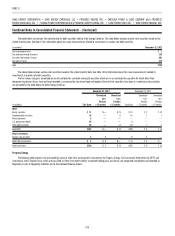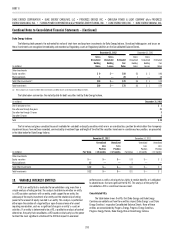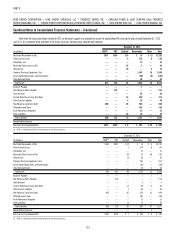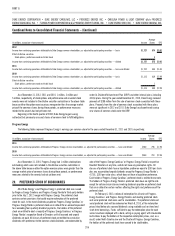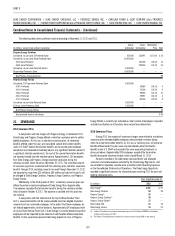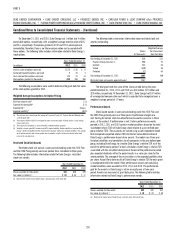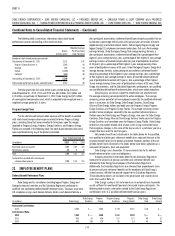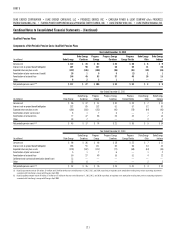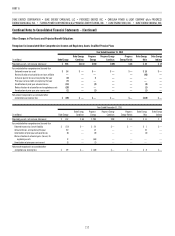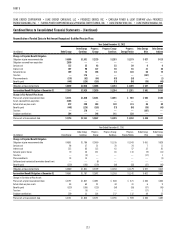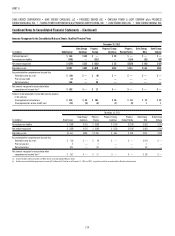Duke Energy 2012 Annual Report Download - page 224
Download and view the complete annual report
Please find page 224 of the 2012 Duke Energy annual report below. You can navigate through the pages in the report by either clicking on the pages listed below, or by using the keyword search tool below to find specific information within the annual report.
204
PART II
DUKE ENERGY CORPORATION • DUKE ENERGY CAROLINAS, LLC • PROGRESS ENERGY, INC. • CAROLINA POWER & LIGHT COMPANY d/b/a PROGRESS
ENERGY CAROLINAS, INC. • FLORIDA POWER CORPORATION d/b/a PROGRESS ENERY FLORIDA, INC. • DUKE ENERGY OHIO, INC. • DUKE ENERGY INDIANA, INC.
Combined Notes to Consolidated Financial Statements – (Continued)
DS Cornerstone, LLC, a 50/50 joint venture entity with a third-party joint
venture partner, owns two windpower projects and has executed a third -
party fi nancing against the two windpower projects. DS Cornerstone was a
consolidated VIE of Duke Energy through August 31, 2012, as the members
equity was not suffi cient to support the operations of the joint venture as
demonstrated by the third -party fi nancing. Duke Energy provided a Production
Tax Credit (PTC) Remedy Agreement to the joint venture partner whereby Duke
Energy guaranteed the two windpower projects would achieve commercial
operation in 2012 and an agreed to number of wind turbines would qualify for
production tax credits. In the event the agreed to number of wind turbines of
the two wind generating facilities failed to qualify, the joint venture partner had
the option to put its equity ownership interest back to Duke Energy. The PTC
Remedy Agreement resulted in greater loss exposure to Duke Energy and, as a
result, Duke Energy consolidated DS Cornerstone, LLC through August 31, 2012,
until both projects reached commercial operation and the appropriate number
of wind turbines qualifi ed for PTC. As of December 31, 2012, DS Cornerstone
is a non-consolidated VIE. The most signifi cant activities that impact DS
Cornerstone’s economic performance are the decisions related to the ongoing
operations and maintenance activities. The power to direct these activities is
jointly and equally shared by Duke Energy and Sumitomo. As a result, Duke
Energy does not consolidate the DS Cornerstone. Accordingly, DS Cornerstone is
a non-consolidated VIE that is reported as an equity method investment.
FPC Capital I Trust.
Progress Energy has variable interests in the FPC Capital I Trust (the Trust)
which is a VIE of which Duke Energy is not the primary benefi ciary. The Trust,
a fi nance subsidiary, was established in 1999 for the sole purpose of issuing
$300 million of 7.10% Cumulative Quarterly Income Preferred Securities due
2039, and using the proceeds thereof to purchase from Florida Progress Funding
Corporation (Funding Corp.), a wholly owned subsidiary of Progress Energy,
$300 million of 7.10% Junior Subordinated Deferrable Interest Notes due 2039.
The Trust has no other operations and its sole assets are the subordinated
notes and related guarantees. Funding Corp. was formed for the sole purpose
of providing fi nancing to Progress Energy Florida and its subsidiaries. Funding
Corp. does not engage in business activities other than such fi nancing and has
no independent operations. Progress Energy has guaranteed the payments of all
distributions required by the trust.
Other.
Duke Energy has investments in various other entities that are VIEs which
are not consolidated. The most signifi cant of these investments is Duke Energy
Ohio’s 9% ownership interest in OVEC. Through its ownership interest in OVEC,
Duke Energy Ohio has a contractual arrangement through June 2040 to buy
power from OVEC’s power plants. The proceeds from the sale of power by OVEC
to its power purchase agreement counterparties, including Duke Energy Ohio, are
designed to be suffi cient for OVEC to meet its operating expenses, fi xed costs, debt
amortization and interest expense, as well as earn a return on equity. Accordingly,
the value of this contract is subject to variability due to fl uctuations in power
prices and changes in OVEC’s costs of business, including costs associated with
its 2,256 megawatts of coal-fi red generation capacity. As discussed in Note 5, the
proposed rulemaking on cooling water intake structures, MATS, CSAPR and CCP’s
could increase the costs of OVEC which would be passed through to Duke Energy
Ohio. The initial carrying value of this contract was recorded as an intangible
asset when Duke Energy acquired Cinergy in April 2006.
In addition, the company has guaranteed the performance of certain
entities in which the company no longer has an equity interest. As a result, the
company has a variable interest in certain other VIEs that are non-consolidated.
CRC.
As discussed above, CRC is consolidated only by Duke Energy.
Accordingly, the retained interest in the sold receivables recorded on the
Consolidated Balance Sheets of Duke Energy Ohio and Duke Energy Indiana are
eliminated in consolidation at Duke Energy.
The proceeds obtained from the sales of receivables are largely cash but
do include a subordinated note from CRC for a portion of the purchase price
(typically approximates 25% of the total proceeds). The subordinated note is
a retained interest (right to receive a specifi ed portion of cash fl ows from the
sold assets) and is classifi ed within Receivables in Duke Energy Ohio’s and
Duke Energy Indiana’s Consolidated Balance Sheets at December 31, 2012 and
2011, respectively. The retained interests refl ected on the Consolidated Balance
Sheets of Duke Energy Ohio and Duke Energy Indiana approximate fair value.
The carrying values of the retained interests are determined by allocating
the carrying value of the receivables between the assets sold and the interests
retained based on relative fair value. Because the receivables generally turnover
in less than two months, credit losses are reasonably predictable due to the
broad customer base and lack of signifi cant concentration, and the purchased
benefi cial interest (equity in CRC) is subordinate to all retained interests and
thus would absorb losses fi rst, the allocated basis of the subordinated notes are
not materially different than their face value. The hypothetical effect on the fair
value of the retained interests assuming both a 10% and a 20% unfavorable
variation in credit losses or discount rates is not material due to the short
turnover of receivables and historically low credit loss history. Interest accrues
to Duke Energy Ohio and Duke Energy Indiana on the retained interests using
the acceptable yield method, which generally approximates the stated rate on
the notes since the allocated basis and the face value are nearly equivalent. An
impairment charge is recorded against the carrying value of both the retained
interests and purchased benefi cial interest whenever it is determined that an
other-than-temporary impairment has occurred. The key assumptions used in
estimating the fair value in 2012 and 2011 is detailed in the following table:
2012 2011
Duke Energy Ohio
Anticipated credit loss ratio 0.7% 0.8%
Discount rate 1.2% 2.6%
Receivable turnover rate 12.7% 12.7%
Duke Energy Indiana
Anticipated credit loss ratio 0.3% 0.4%
Discount rate 1.2% 2.6%
Receivable turnover rate 10.2% 10.2%




